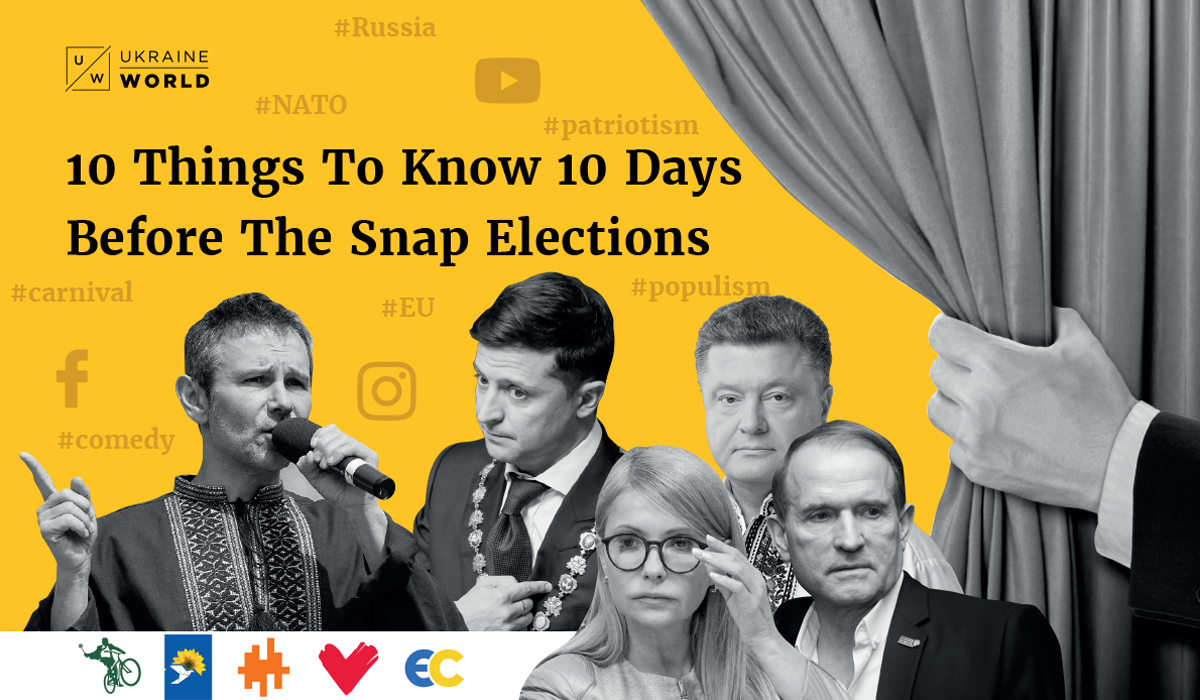Ukraine’s snap parliamentary elections will take place in 10 days time. We have prepared a “survival guide” for you: here are 10 key things to know ahead of the vote.
- There are many new political forces running for Parliament this year. All of these "new faces" hope to take advantage of the mood of voters who feel fatigue from the old political system and are desperate for positive change. Among the new parties, Servant of the People, Holos, and Might and Honor have the best chance of making it to the Verkhovna Rada and being represented in the new government.
- Servant of the People and Holos prioritize mainly young candidates, often in their 30s. Some other parties—like Ukrainian Strategy of Volodymyr Groysman—also follow this trend. Therefore, these elections could be a major reset of generations in Ukrainian politics. While the coming of young people into Parliament was also present in 2014, these elections can make this trend even more visible.
- Holos Party led by rock singer Sviatoslav Vakarchuk is in many aspects very similar to Servant of the People. Both parties use the demand for "fresh faces", and have drawn up their lists of young people who have never been MPs before. However, while Holos might have aimed at competing with Servant of the People, it is, in fact, possible that it is taking votes from Poroshenko's European Solidarity. Holos sees most support in Western Ukraine, especially in Lviv Region, where the majority voted for Poroshenko at the presidential elections.
- For the first time ever in Ukraine's history, one party—Zelensky's Servant of the People—has a legitimate, mathematical chance to form a one-party majority in the Ukrainian Parliament. However, despite the tremendous gap in the ratings between Servant of the People and the others, the final composition of Parliament is not that easy to predict. Voting for party lists forms only one part of Parliament. The other part will be formed by single MPs who compete in first-past-the-post constituencies. As citizens will have two choices to make, it is not easy to predict whether they will vote for representatives of one force or different forces.
- There are two major parties with more pro-Russian rhetoric and with former members of Yanukovych's Party of Regions: Opposition Platform—For Life and the Opposition Bloc. These are supported by conflicting oligarchs: Viktor Medvedchuk and Rinat Akhmetov, respectively. While earlier pro-Russian parties were usually consolidated, today we have two branches of one previous political force, competing for more pro-Russian voters. For now, according to opinion polls, Opposition Platform—For Life leads—it polls around 13%, while the Opposition Bloc polls around 3%.
- Polarization of Ukrainian society clearly present at the presidential elections continues today. This polarization is rather internally political—between Zelensky and Poroshenko voters—rather than geopolitical. Both Zelensky and Poroshenko voters seem to be supporting the pro-Western vector. Furthermore, all those parties which have a shot at making it through the 5% voting barrier necessary to create a parliamentary faction, except for Opposition Platform—For Life, fully support EU and NATO integration.
- This is quite a chaotic campaign. It is experiencing a high level of legal controversy, especially when it comes to issues like whether certain parties or politicians can be registered or not. Additionally, the parties had only two months for a fully fleshed-out electoral campaign, therefore many activities—like electoral tours around Ukraine—have been rushed.
- Ukrainian parties are going digital. Empowered by the results of presidential digital populism, parties have decided to use digital tools in their campaigns. Instagram videos, hashtags and informal pictures are being tested by various parties. Alongside digital tools, old tools (banners, flyers, TV ads) are still the case for the majority of parties. However, not everyone understood why Zelensky won the presidential elections. Most parties are still staking on old slogans and boring billboards, and almost no-one except for Servant of the People, uses memes.
- In terms of social media presence, Servant of the People remains dominant on Instagram, the fastest growing social network in Ukraine. While facing some fierce criticism from Poroshenko's supporters on Facebook, Instagram users still favour Zelensky's party more than Poroshenko's European Solidarity.
- Russian social media VKontakte, banned in Ukraine since 2017, still remains mostly pro-Russian in Ukraine. Due to its most popular groups and authors, it serves as a breeding ground for pro-Kremlin narratives about Ukrainian politics. Interestingly, some top pro-Russian authors have been critical of all the main Ukrainian parties and candidates, including the party leaning most towards Russia, the pro-Russian Opposition Platform—For Life.
This article was prepared with support from the International Renaissance Foundation

